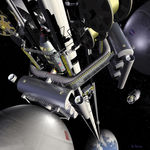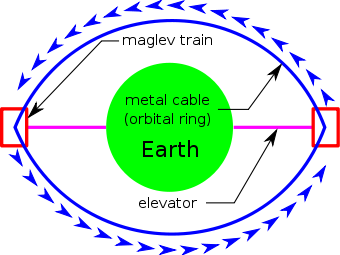- Orbital ring
-
An Orbital Ring is a concept for a space elevator that consists of a ring in low earth orbit that rotates at above orbital speed, that has fixed tethers hanging down to the ground.
The structure is intended to be used for space launch.
The original orbital ring concept is related to the space fountain and launch loop and was explored in detail by Paul Birch and published in three parts in the Journal of the British Interplanetary Society in 1982.
Contents
History
Arthur C. Clarke published a book called The Fountains of Paradise about space elevators, but which in an appendix referred to an idea to launch things off the Earth using a structure based on mass drivers. The idea apparently did not work, but this inspired further research.
Paul Birch publishes a series of articles in the Journal of the British Interplanetary Society (JBIS) in 1982.
Anatoly E. Yunitsky also published a similar idea in 1982.[1]
Birch's model
In the simplest design of an orbital ring system, a rotating cable or possibly an Inflatable space structure is placed in a low Earth orbit above the equator, rotating at faster than orbital speed. Not in orbit, but riding on this ring, supported electromagnetically on superconducting magnets, are ring stations that stay in one place above some designated point on Earth. Hanging down from these ring stations are short space elevators made from cables with high tensile strength to mass ratio materials.
Although this simple model would work best above the equator, Paul Birch found that since the ring station can be used to accelerate the orbital ring eastwards as well as hold the tether, it is therefore possible to deliberately cause the orbital ring to precess around the Earth instead of staying fixed in space while the Earth rotates beneath it. By precessing the ring once every 24 hours, the Orbital Ring will hover above any meridian selected on the surface of the Earth. The cables which dangle from the ring are now geostationary without having to reach geostationary altitude or without having to be placed into the equatorial plane. This means that using the Orbital Ring concept, one or many pairs of Stations can be positioned above any points on Earth desired or can be moved everywhere on the globe. Thus, any point on Earth can be served by a space elevator. Also a whole network of orbital rings can be built, which, by crossing over the poles, could cover the whole planet and be capable of taking over most of freight and passenger transport. By an array of elevators and several geostationary ring stations, asteroid or Moon material can be received and gently put down where land fills are needed. The electric energy generated in the process would pay for the system expansion and ultimately could pave the way for a solar-system-wide terraforming- and astroengineering-activity on a sound economical basis.
If built by launching the necessary materials from Earth, the estimated cost for the system in 1980s money was around $31 trillion if launched using Shuttle-derived hardware,[2] whereas it could fall to $15 billion with bootstrapping, assuming a large orbital manufacturing facility is available to provide the initial 18,000 tonnes of steel, aluminium, and slag at a low cost,[3] and even lower with orbital rings around the moon. The system's cost per kilogram to place payloads in orbit would be around $0.05.[4]
Types of orbital rings
The simplest type would be a circular orbital ring in LEO.
Two other types were also defined by Paul Birch:
- Eccentric orbital ring systems - these are rings that are in the form of a closed shape with varying altitude
- Partial orbital ring systems[5]- this is essentially a Launch loop
In addition, he proposed the concept of "supramundane worlds" such as supra-jovian and supra-stellar "planets". These are artificial planets that would be supported by a grid of orbital rings that would be positioned above a planet, supergiant or even a star.
Orbital rings in fiction
Donald Kingsbury described a partial ring (a few hundred kilometers long) in his novel The Moon Goddess and the Son.
The manga Battle Angel Alita prominently features a slightly deteriorated orbital ring.
The second iteration of the anime series Tekkaman features a complete ring, though abandoned and in disrepair due to war, and without surface tethers.
The anime series Kiddy Grade also uses orbital rings as a launch and docking bay for spaceships. These rings are connected to large towers extending from the planets surface.
Orbital rings are used extensively in the collaborative fiction worldbuilding website Orion's Arm.[6]
Arthur C. Clarke's 3001: The Final Odyssey features an orbital ring with differing levels of gravity, provided by the centripetal force of the ring's spinning.
References
- ^ Техника-молодежи» 1982 №6, с.34-36 -"Technical youth" 1982 (Russian)
- ^ "Orbital Ring Systems and Jacob's Ladders - II" section 3.2
- ^ "Orbital Ring Systems and Jacob's Ladders - II" section 3.5
- ^ "Orbital Ring Systems and Jacob's Ladders - I-III"
- ^ Paul Birch Orbital Rings-I 12
- ^ Space Fountains and Orbital Rings
See also
- Space elevator
- Space fountain
- Launch loop
- Megascale engineering
- Ringworld
- Space tether
- Non-rocket spacelaunch
External links
 Media related to Orbital ring at Wikimedia Commons
Media related to Orbital ring at Wikimedia CommonsSpace elevator Main articles 
Concepts Technologies Competitions Space elevator games · Elevator:2010 · European Space Elevator Challenge · Japan Space Elevator & Technical CompetitionPeople Organizations Non-rocket spacelaunch Static structures CompressiveSpace towerTensileBolusRotovators · Hypersonic bolusOtherEndo-atmospheric tethers
Dynamic structures Projectile launchers ElectricalChemicalMechanicalSlingatronReaction drives Buoyant lifting Categories:
Wikimedia Foundation. 2010.

